
Historic Railway, Frankfurt
Encyclopedia
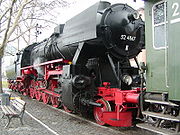

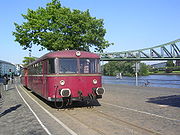
Steam locomotive
A steam locomotive is a railway locomotive that produces its power through a steam engine. These locomotives are fueled by burning some combustible material, usually coal, wood or oil, to produce steam in a boiler, which drives the steam engine...
s, as technical and cultural monuments.
Since 1979 there has been a regular museum service several weekends a year on the tracks of the Frankfurt Harbour Railway (Frankfurter Hafenbahn) between the halts of Mainkur, Eiserner Steg and Frankfurt-Griesheim. Since 1981 the society has organised the Königstein railway festival (Bahnhofsfest Königstein) every year at Whitsun, when the Königsteiner Bahn between Frankfurt-Höchst and Königstein im Taunus
Königstein im Taunus
Königstein im Taunus is a climatic spa and lies on the thickly wooded slopes of the Taunus in Hesse, Germany. Owing to its advantageous location for both scenery and transport on the edge of the Frankfurt Rhine Main Region, Königstein is a favourite residential town...
is operated. In addition vehicles of the Historic Railway, Frankfurt are used in special services throughout Germany.
Rolling stock
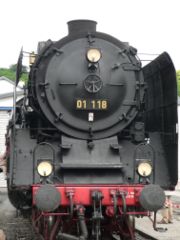
.jpg)
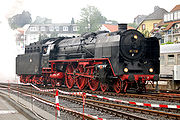
DRG Class 01
The Deutsche Reichsbahn-Gesellschaft's BR 01 steam locomotives were the first standardised steam express passenger locomotives built by the unified German railway system. They were of 4-6-2 "Pacific" wheel arrangement in the Whyte notation, or 2′C1′ h2 in the UIC classification. The idea of...
express train, steam locomotive, number 01 118.
Steam locomotive 01 118
The locomotive was built by KruppKrupp
The Krupp family , a prominent 400-year-old German dynasty from Essen, have become famous for their steel production and for their manufacture of ammunition and armaments. The family business, known as Friedrich Krupp AG Hoesch-Krupp, was the largest company in Europe at the beginning of the 20th...
in Essen
Essen
- Origin of the name :In German-speaking countries, the name of the city Essen often causes confusion as to its origins, because it is commonly known as the German infinitive of the verb for the act of eating, and/or the German noun for food. Although scholars still dispute the interpretation of...
in 1934 under works number 1415 and is the only one of its class still in existence today that has seen unbroken operational service. It was delivered on 18 December 1934 and officially taken over by the Deutsche Reichsbahn
Deutsche Reichsbahn
Deutsche Reichsbahn was the name of the following two companies:* Deutsche Reichsbahn, the German Imperial Railways during the Weimar Republic, the Third Reich and the immediate aftermath...
on 24 December 1934. The purchase price for the engine and tender was 208,597 Reichsmarks. It began its duties on 2 January 1935 and in March 1939 it was fitted with an inductive train control
Punktförmige Zugbeeinflussung
PZB or Indusi is an intermittent cab signalling system and train protection system used in Germany, Austria, Slovenia, Croatia, Romania, Israel and on one line in Canada....
(PZB).
Over the course of time, the locomotive was stationed in various central German locomotive sheds (Betriebswerke. After the end of the Second World War it was left in the Soviet Zone of Occupation and was incorporated in the Deutsche Reichsbahn's fleet in East Germany, where it was given the computer number 01 2118-6 in 1970.
During its entire service the Reichsbahn did not carry out any major conversion or modernisation of the engine. As a result, its appearance has remained unchanged; something which is especially evinced by the large Wagner
Richard Paul Wagner
Richard Felix Paul Wagner was the Chief of Design in the design office of the Deutsche Reichsbahn in Germany from its inception in 1922 to 1942.. He held the rank of Reichsbahnoberrat....
smoke deflectors. Instead of the original rivetted tender, the locomotive was coupled with a Class 2'2'T 34 tender which was delivered by Borsig in 1941 under the works number 15117. Over the course of the years the boiler has been replaced several times. Its present boiler, which is the seventy, was fitted in July 1973. It came originally from locomotive 01 191, built in 1937, and was last used on locomotive 01 089.
Until its sale to the Historic Railway, Frankfurt, on 5 November 1981 it had covered 3,559,271 kilometres according to its log. Her last locomotive depot (Bahnbetriebswerk) was Bw Saalfeld in the Reichsbahn division of Erfurt.
Its sale was handled by the Kunst und Antiquitäten GmbH, a branch of the Kommerzielle Koordinierung. This government department of East Germany's Foreign Ministry, headed by Alexander Schalck-Golodkowski
Alexander Schalck-Golodkowski
Alexander Schalck-Golodkowski was a politician and trader in the German Democratic Republic. He was director of a main department in the Ministry for Foreign Trade and German Domestic Trade , the Deputy Minister for External Trade , and head of the GDR's Kommerzielle Koordinierung .He was born in...
, had the task of acquiring foreign exchange assets through the sale of art and antiquities to customers in the West. After the bill of sale had been paid, the locomotive was on its way to the West on 7 November 1981 together with two other historic locomotives, numbers 35 1097 (formerly 23 1097) and 03 2098.
Since 1981 the locomotive has been used for steam specials, initially on the Frankfurt Harbour Railway and since 1985 on public railway lines. The engine underwent the required general inspections in 1991, 1995, 1999 and 2003 and can therefore continue to be used for special trips, that have taken it so far to France
France
The French Republic , The French Republic , The French Republic , (commonly known as France , is a unitary semi-presidential republic in Western Europe with several overseas territories and islands located on other continents and in the Indian, Pacific, and Atlantic oceans. Metropolitan France...
, Luxembourg
Luxembourg
Luxembourg , officially the Grand Duchy of Luxembourg , is a landlocked country in western Europe, bordered by Belgium, France, and Germany. It has two principal regions: the Oesling in the North as part of the Ardennes massif, and the Gutland in the south...
, the Netherlands
Netherlands
The Netherlands is a constituent country of the Kingdom of the Netherlands, located mainly in North-West Europe and with several islands in the Caribbean. Mainland Netherlands borders the North Sea to the north and west, Belgium to the south, and Germany to the east, and shares maritime borders...
and Switzerland
Switzerland
Switzerland name of one of the Swiss cantons. ; ; ; or ), in its full name the Swiss Confederation , is a federal republic consisting of 26 cantons, with Bern as the seat of the federal authorities. The country is situated in Western Europe,Or Central Europe depending on the definition....
. In spring 2004 the locomotive was fitted with the PZB 90
Punktförmige Zugbeeinflussung
PZB or Indusi is an intermittent cab signalling system and train protection system used in Germany, Austria, Slovenia, Croatia, Romania, Israel and on one line in Canada....
train safety system. She is stationed at Frankfurt Eastern Harbour.
Up to 2006 the specials were organised by the Nuremberg Transport Museum
Nuremberg Transport Museum
The Nuremberg Transport Museum is based in Nuremberg, Germany, and consists of the Deutsche Bahn's own DB Museum and the Museum of Communications . It also has two satellite museums at Koblenz-Lützel and Halle...
. In addition to the traditional events held by the Historic Railway, Frankfurt, she also took part, for example, in the Frankfurt Harbour celebrations in August 2006, as part of the 'Rhine-Main route of industrial heritage'.
Apart from the numerous photographs and films, that railway fans and train spotters have produced on her appearances, the locomotive played an important side role in the 2001 TV melodrama Geraubte Liebe ('Stolen Love'), that was shown by Hessischer Rundfunk
Hessischer Rundfunk
Hessischer Rundfunk is the public broadcaster for the German state of Hesse. The main offices of HR are in Frankfurt am Main. HR is a member of the ARD.- Studios :...
.
Locomotive 01 118 is the prototype for several models in various gauges. In 2004, for their 70th anniversary, a model railway manufacturer in Viernheim
Viernheim
Viernheim is a midsize industrial town on Mannheim’s outskirts and is found in the Rhine Neckar agglomeration and economic area. It is the second biggest town in Bergstraße district in Hesse, Germany...
made a brass model of 01 118 in 1:45 (I) scale, that was produced as a limited edition. It is also available as a model from the trade in TT gauge.
Steam locomotive 52 4867
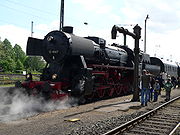

Austria
Austria , officially the Republic of Austria , is a landlocked country of roughly 8.4 million people in Central Europe. It is bordered by the Czech Republic and Germany to the north, Slovakia and Hungary to the east, Slovenia and Italy to the south, and Switzerland and Liechtenstein to the...
after the Second World War. In 1980 it was acquired by the Historic Railway, Frankfurt, from the Graz-Köflacher Eisenbahn- und Bergbaugesellschaft.
She carried out an unusual duty in October 2007. When the tracks on the curve of the Bäderbahn (Homburger Damm) – a link line in west Frankfurt normally worked by the Taunusbahn – needed to be completely refurbished, the firm carrying it out decided on cost grounds, to charter the goods train locomotive from the Historic Railway, Frankfurt, as motive power for the heavy works trains. Number 52 4867 hauled wagons laden with track ballast
Track ballast
Track ballast forms the trackbed upon which railway sleepers or railroad ties are laid. It is packed between, below, and around the ties. It is used to facilitate drainage of water, to distribute the load from the railroad ties, and also to keep down vegetation that might interfere with the track...
in a 64-hour continuous shift to the Frankfurt (Main) Höchst goods station. Likewise she was used for duties on the Main-Neckar bridge at Easter
Easter
Easter is the central feast in the Christian liturgical year. According to the Canonical gospels, Jesus rose from the dead on the third day after his crucifixion. His resurrection is celebrated on Easter Day or Easter Sunday...
2008.
Other locomotives
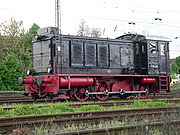
- Two former military (WehrmachtWehrmachtThe Wehrmacht – from , to defend and , the might/power) were the unified armed forces of Nazi Germany from 1935 to 1945. It consisted of the Heer , the Kriegsmarine and the Luftwaffe .-Origin and use of the term:...
) diesel locomotiveDiesel locomotiveA diesel locomotive is a type of railroad locomotive in which the prime mover is a diesel engine, a reciprocating engine operating on the Diesel cycle as invented by Dr. Rudolf Diesel...
s of class V 36. These two Deutsche BundesbahnDeutsche BundesbahnThe Deutsche Bundesbahn or DB was formed as the state railway of the newly established Federal Republic of Germany on September 7, 1949 as a successor of the Deutsche Reichsbahn-Gesellschaft '...
engines, V 36 405 and V 36 406, built in 1950, were acquired by the HEF after their retirement in 1981 and 1979 respectively. Of the two, number V 36 406 remains in working condition. - A DRG Köf II shunter. Köf 5712, built in 1942 was initially used at the PeenemündePeenemündeThe Peenemünde Army Research Center was founded in 1937 as one of five military proving grounds under the Army Weapons Office ....
military research institute Heeresversuchsanstalt Peenemünde and ended up in the Deutsche ReichsbahnDeutsche ReichsbahnDeutsche Reichsbahn was the name of the following two companies:* Deutsche Reichsbahn, the German Imperial Railways during the Weimar Republic, the Third Reich and the immediate aftermath...
in ErfurtErfurtErfurt is the capital city of Thuringia and the main city nearest to the geographical centre of Germany, located 100 km SW of Leipzig, 150 km N of Nuremberg and 180 km SE of Hannover. Erfurt Airport can be reached by plane via Munich. It lies in the southern part of the Thuringian...
, East Germany after the Second World War. In 1995 it was retired, was refurbished in 1998 and has been operational since 2000. Another Kö II, number 4293 built in 1934, is in private hands. It has been used, on loan, by the HEF since its restoration in 2004. - A railbusRailbusA railbus is a very lightweight type passenger rail vehicle that shares many aspects of their construction with a bus, usually having a bus, or modified bus body, and having four wheels on a fixed base, instead of on bogies...
set of class VT 98Uerdingen railbusThe Uerdingen railbus is the common term for the multiple units which were developed by the German firm of Waggonfabrik Uerdingen for the Deutsche Bundesbahn and private railways after the Second World War. These vehicles were diesel-powered, twin-axle railbuses of light construction...
, comprising the traction car 798 629-2, the driving car 996 683-9 and the two trailer cars 998 175-4 and 996 257-5, was made available to the HEF by a railway society. The traction car, control car and first trailer car are working.
Passenger coaches
The society has a range of historic passenger coaches, including 13 eight-wheeled wagons of class Bm 234, a saloon car as well as twelve six-wheeled Class 3ygUmbau-Wagen
The Umbau-Wagen or Umbauwagen was a type of German railway passenger coach operated by the Deutsche Bundesbahn which appeared in the mid-1950s...
coaches.

